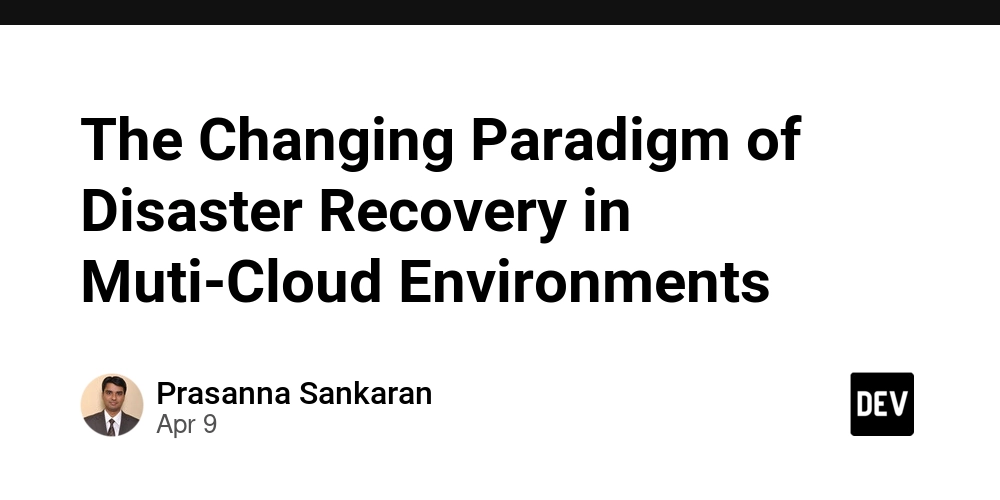The Changing Paradigm of Disaster Recovery in Muti-Cloud Environments
Disaster Recovery is the process of restoring business operations and IT infrastructure after a disastrous event such as natural disasters, cyberattacks or human error. It involves implementing strategies, plan, and technologies to minimize downtime, recover data and resume normal business functions as quickly as possible. A multi-cloud strategy for disaster recovery involves utilizing multiple cloud service providers to enhance resilience and redundancy in disaster recovery planning. A recent study suggests, over 82 percent of organizations already use more than one cloud provider. Instead of relying on a single cloud provider, businesses leverage multiple cloud vendors to store data, run applications, and facilitate recovery processes. Significance of Disaster Recovery The amount of data lost without a disaster recovery strategy can vary significantly depending on several factors, including the nature of the disaster, the robustness of the organization’s backup systems, and the speed of response to the incident. Even if backup systems are in place, outdated or inadequate backup procedure may result in significant data loss along with encountering challenges during the recovery process, such as data corruption, compatibility issues or insufficient resources. Suitable businesses for Multi-cloud Disaster Recovery Multi-cloud disaster recovery is well-suited for various Organizations such as e-commerce platforms which rely heavily on continuous availability to serve customers and process transactions. Multi-cloud disaster recovery ensures that e-commerce platforms can quickly recover from outages or disruptions, minimizing revenue loss and preserving customer satisfaction. Financial Services such as banks and investment firms require resilient IT infrastructures to maintain transactional integrity and regulatory compliance. Multi-cloud disaster recovery helps mitigate risks associated with system failures, data breaches and cyberattacks. Multi-cloud disaster recovery also resonates with healthcare systems providing redundancy and failover capabilities to ensure continuous access to medical imaging systems, electronic health records, and critical healthcare applications. Implementing Multi-cloud strategy for Disaster Recovery The first and foremost step in the implementation of multi-cloud strategy for disaster recovery starts with evaluating the current infrastructure, and data to determine their criticality and recovery objectives and identify potential risks and vulnerabilities. Choosing multiple cloud providers based on factors like geographic locations, reliability, cost, and compliance requirements becomes a very critical factor. Implementing data replication and backup solutions ensures redundancy and minimizes the risk of data loss in case of a disaster. Setting up automated failover and recovery processes to quickly switch to alternate cloud environments in the event of a failure. This may involve using tools such as Kubernetes for container orchestration or cloud-native services provided by the chosen providers. Implement robust security measures to protect data in the cloud including encryption, access controls, identity management, and compliance with relevant regulatory requirements. Deploy monitoring and alerting systems to continuously monitor the health and performance of multi-cloud infrastructure. Periodically review and optimize multi-cloud strategy to adapt to changes in infrastructure, technology advancements, and evolving business requirements. Documentation of the multi-cloud disaster recovery strategy and providing training to relevant stakeholders to ensure that personnel involved understand the roles and responsibilities is a mandatory step. Finally, regular testing of disaster recovery processes is important to ensure they function as expected. Conduct simulated disaster scenarios to validate the effectiveness of multi-cloud strategy. Dynamic scenery of Multi-cloud disaster recovery strategy Multi-cloud architectures are becoming more common as organizations leverage the power of different cloud providers to avoid vendor lock-ins. Containerization technologies, such as Docker, and orchestration platforms, like Kubernetes, are becoming an integral part of multi-cloud Disaster Recovery. These technologies make it easier to port, scale, and automate disaster recovery. Serverless computing is becoming increasingly popular for disaster recovery scenarios, as it eliminates the need for provisioning and managing servers. The emergence of edge computing brings with it new challenges and opportunities. Multi-cloud disaster recovery requires specialized disaster recovery solutions tailored to their specific needs, such as connectivity and resource limitations. Multi-cloud disaster recovery continues to face regulatory compliance and data security challenges. Organizations need to ensure compliance and implement strong security measures to protect data in the cloud.

Disaster Recovery is the process of restoring business operations and IT infrastructure after a disastrous event such as natural disasters, cyberattacks or human error. It involves implementing strategies, plan, and technologies to minimize downtime, recover data and resume normal business functions as quickly as possible.
A multi-cloud strategy for disaster recovery involves utilizing multiple cloud service providers to enhance resilience and redundancy in disaster recovery planning. A recent study suggests, over 82 percent of organizations already use more than one cloud provider. Instead of relying on a single cloud provider, businesses leverage multiple cloud vendors to store data, run applications, and facilitate recovery processes.
Significance of Disaster Recovery
The amount of data lost without a disaster recovery strategy can vary significantly depending on several factors, including the nature of the disaster, the robustness of the organization’s backup systems, and the speed of response to the incident. Even if backup systems are in place, outdated or inadequate backup procedure may result in significant data loss along with encountering challenges during the recovery process, such as data corruption, compatibility issues or insufficient resources.
Suitable businesses for Multi-cloud Disaster Recovery
Multi-cloud disaster recovery is well-suited for various Organizations such as e-commerce platforms which rely heavily on continuous availability to serve customers and process transactions. Multi-cloud disaster recovery ensures that e-commerce platforms can quickly recover from outages or disruptions, minimizing revenue loss and preserving customer satisfaction. Financial Services such as banks and investment firms require resilient IT infrastructures to maintain transactional integrity and regulatory compliance. Multi-cloud disaster recovery helps mitigate risks associated with system failures, data breaches and cyberattacks. Multi-cloud disaster recovery also resonates with healthcare systems providing redundancy and failover capabilities to ensure continuous access to medical imaging systems, electronic health records, and critical healthcare applications.
Implementing Multi-cloud strategy for Disaster Recovery
The first and foremost step in the implementation of multi-cloud strategy for disaster recovery starts with evaluating the current infrastructure, and data to determine their criticality and recovery objectives and identify potential risks and vulnerabilities. Choosing multiple cloud providers based on factors like geographic locations, reliability, cost, and compliance requirements becomes a very critical factor. Implementing data replication and backup solutions ensures redundancy and minimizes the risk of data loss in case of a disaster. Setting up automated failover and recovery processes to quickly switch to alternate cloud environments in the event of a failure. This may involve using tools such as Kubernetes for container orchestration or cloud-native services provided by the chosen providers. Implement robust security measures to protect data in the cloud including encryption, access controls, identity management, and compliance with relevant regulatory requirements. Deploy monitoring and alerting systems to continuously monitor the health and performance of multi-cloud infrastructure. Periodically review and optimize multi-cloud strategy to adapt to changes in infrastructure, technology advancements, and evolving business requirements. Documentation of the multi-cloud disaster recovery strategy and providing training to relevant stakeholders to ensure that personnel involved understand the roles and responsibilities is a mandatory step. Finally, regular testing of disaster recovery processes is important to ensure they function as expected. Conduct simulated disaster scenarios to validate the effectiveness of multi-cloud strategy.
Dynamic scenery of Multi-cloud disaster recovery strategy
Multi-cloud architectures are becoming more common as organizations leverage the power of different cloud providers to avoid vendor lock-ins. Containerization technologies, such as Docker, and orchestration platforms, like Kubernetes, are becoming an integral part of multi-cloud Disaster Recovery. These technologies make it easier to port, scale, and automate disaster recovery. Serverless computing is becoming increasingly popular for disaster recovery scenarios, as it eliminates the need for provisioning and managing servers. The emergence of edge computing brings with it new challenges and opportunities. Multi-cloud disaster recovery requires specialized disaster recovery solutions tailored to their specific needs, such as connectivity and resource limitations. Multi-cloud disaster recovery continues to face regulatory compliance and data security challenges. Organizations need to ensure compliance and implement strong security measures to protect data in the cloud.




























![[Webinar] AI Is Already Inside Your SaaS Stack — Learn How to Prevent the Next Silent Breach](https://blogger.googleusercontent.com/img/b/R29vZ2xl/AVvXsEiOWn65wd33dg2uO99NrtKbpYLfcepwOLidQDMls0HXKlA91k6HURluRA4WXgJRAZldEe1VReMQZyyYt1PgnoAn5JPpILsWlXIzmrBSs_TBoyPwO7hZrWouBg2-O3mdeoeSGY-l9_bsZB7vbpKjTSvG93zNytjxgTaMPqo9iq9Z5pGa05CJOs9uXpwHFT4/s1600/ai-cyber.jpg?#)













































































































































![[The AI Show Episode 144]: ChatGPT’s New Memory, Shopify CEO’s Leaked “AI First” Memo, Google Cloud Next Releases, o3 and o4-mini Coming Soon & Llama 4’s Rocky Launch](https://www.marketingaiinstitute.com/hubfs/ep%20144%20cover.png)





































































































































































































![Rogue Company Elite tier list of best characters [April 2025]](https://media.pocketgamer.com/artwork/na-33136-1657102075/rogue-company-ios-android-tier-cover.jpg?#)







































































_Andreas_Prott_Alamy.jpg?width=1280&auto=webp&quality=80&disable=upscale#)































































































![What’s new in Android’s April 2025 Google System Updates [U: 4/18]](https://i0.wp.com/9to5google.com/wp-content/uploads/sites/4/2025/01/google-play-services-3.jpg?resize=1200%2C628&quality=82&strip=all&ssl=1)








![Apple Watch Series 10 Back On Sale for $299! [Lowest Price Ever]](https://www.iclarified.com/images/news/96657/96657/96657-640.jpg)
![EU Postpones Apple App Store Fines Amid Tariff Negotiations [Report]](https://www.iclarified.com/images/news/97068/97068/97068-640.jpg)
![Apple Slips to Fifth in China's Smartphone Market with 9% Decline [Report]](https://www.iclarified.com/images/news/97065/97065/97065-640.jpg)
































































































































